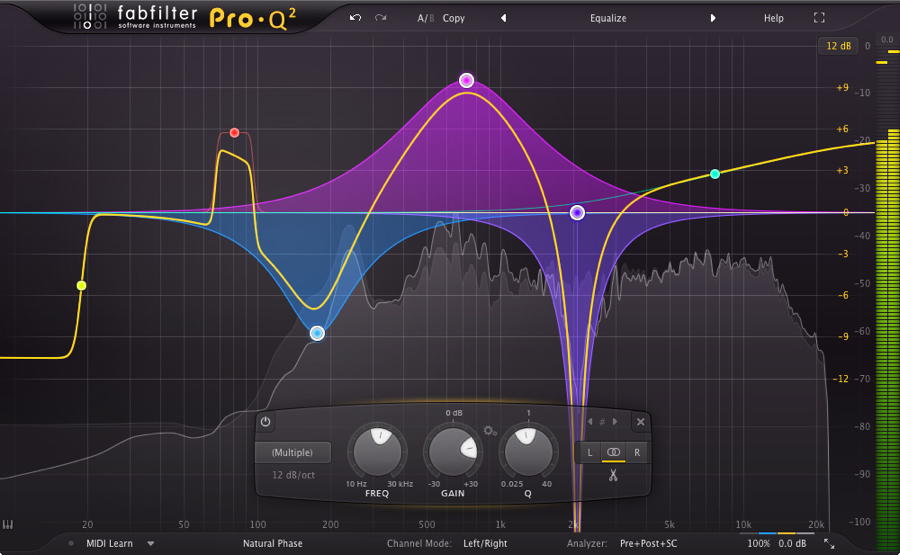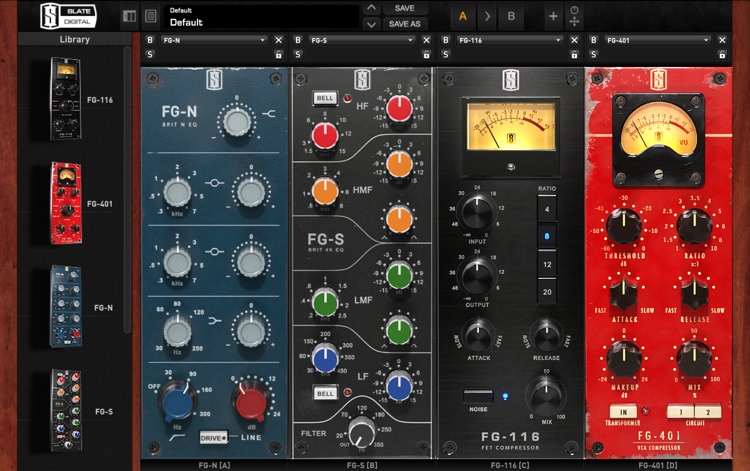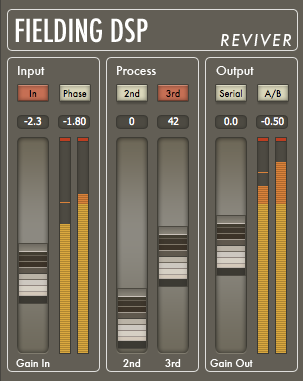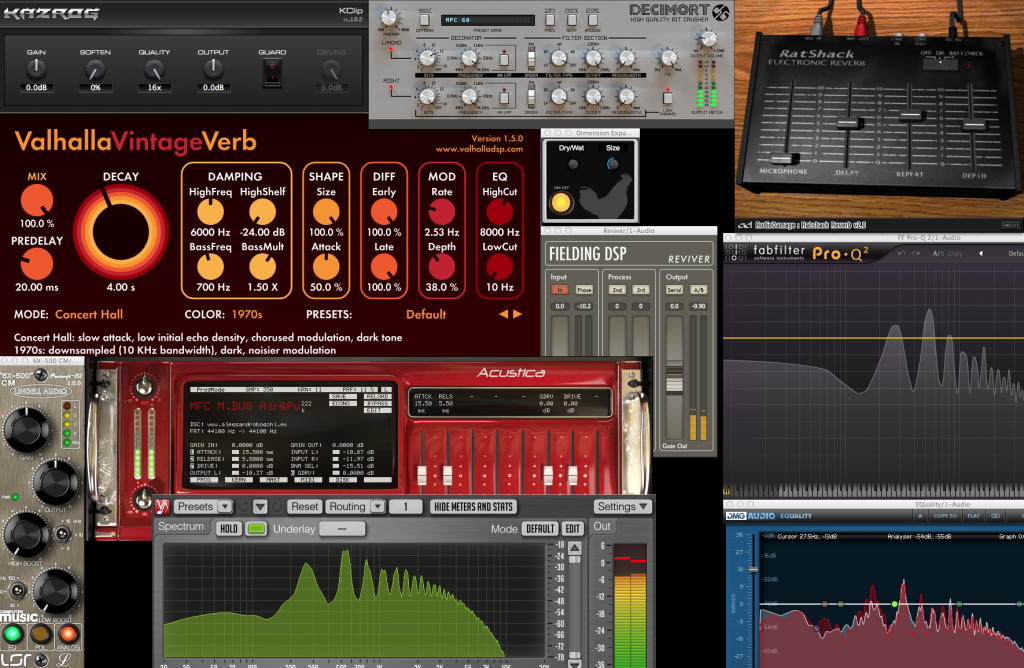
This one’s been in the air for a while: to write about the plugins I use the most. I don’t have an absolute massive ton of plugs, and as I’ve become more experienced, I’ve tried to adapt the “less is more” and “learn a few tools inside out” philosophy with plugins, but I suppose still have/had a few too many “waiting to get used” (I actually ended up deleting a few while going thru the list, trying to pick the ones I’d write about).
For this one, I’ll concentrate on the effects – EQs, saturators, reverb, delay, chorus, etc. – and leave actual instruments for another possible blog post, as they belong in another category and deserve a chapter of their own. I tried to think of the ones I use the most and wouldn’t like to let go of and which have become a part of my steady daily audio diet. Some of these are used in my mastering chain (which I’ve written about in great detail here), some in mixing, some in both.
The idea here is not to write an extensive review of any of them or go through all of their features, but to write about what I happen to like them for.
Without further ado, here we go. This blog post is best enjoyed with quality dark roast coffee, good beer, or, ideally both. I’d love to hear what you were drinking while reading, so please drop a comment below the post re: the drinks OR your thoughts on the post in general. Also, all my blog content is spread on word-of-mouth basis, so you’d do me a massive favor if you shared this post.
Cheers…now have a sip of that drink and dive right in!
 • EQ: Equality by DMGaudio
• EQ: Equality by DMGaudio
This is the first EQ in my mastering chain – there’s actually two instances in the chain: one for mid, one for side. It’s too bad the EQ can’t handle both of them in one instance, but I got past that quite quickly.
The reason I use this one is that it sounds clean. I use it if I need a good high-shelving and/or a boost around sub area or mids. The company says it offers “super-high-quality prototypes. Clear undistorted top”, and I have to agree, as it’s definitely my go-to EQ for high-shelving. I’ve done narrow-Q sniping with it, too, and it sure isn’t bad for that, either, but I have some more specific tools for it.
It is really, really clean – and super light. You can run as many instances as you wish and your CPU won’t mind that much.
• EQ: Ochre EQ by Acustica Audio
This one’s free – do not miss it! Got it somewhat recently, and fell in love.
The “air” you can get with it is simply great. There’s even been a few mastering cases where I’ve really had to push it to breathe some life into a dull premaster, and it does a really great job at that. Definitely my go-to tool when I need that really high-end sizzle or sheen…that airy breath of life. Super great for that. Not really light, but easily worth the “weight”.
• EQ: ProQ2 by Fabfilter
If you like music production and have not been living in a cave for the past year or so, you have heard of this one. This is what many consider the king of EQs today. It boasts plenty of features, but what I like the most about it are:
- Mid/side mode inside one instance – or left/right, alternatively. Both really handy. Another cool feature is right-clicking on a band, which lets you split it into mid and side, so if you want to create a nice space for a sound in the mix, maybe cut a little bit in the mids and do a boost right there in the side signal…ProQ2 makes it easy.
- Spectrum Grab. What this means is if you hover your cursor on the bottom part of the plugin display while audio is running through it, you’ll get a nice graph that draws sharp peaks around the frequencies that are poking out of the mix. This is a super useful feature in terms of finding offending sounds in the mix and cutting them out; you simply grab them with the cursor and pull them down. Try that with a bad drum recording with some annoying whistling resonances and you’ll love it how easy it is.
- Gain Scale. With Spectrum Grab, sometimes I end up doing plenty of cuts in the signal (if there are a plenty of freq peaks that need cutting, of course), and Gain Scale lets you adjust the gain of your cuts (or boosts) ranging from 100 (behaves just as you set your cuts/boosts) down to 0 (your cuts/boosts do nothing) and up to 200 (doubling the magnitude of what you did). Super handy if you think you went slightly overboard with your cuts or think you might use a bit more overall boost.
- Different phase modes from super light to very demanding so you can get the highest possible sound quality if you wish and if your CPU can take it (and if you can actually hear it, that is…)
• EQ/compressor/exciter: Virtual Mix Rack by Slate Digital
VMR offers analog-modeled EQs, compressors, and an exciter. Trust me, they all sound great, and the team has put insane amounts of time in meticulously modelling each part, but the very reason I want to mention VMR here is its (free!) Revival module, which works absolute wonders in terms of exciting the sound. Every time there’s a slightly dull mix, I turn to Revival, which definitely sparkles that lively top end spice on the mix. Sizzlin’!
Personally I’m not a huge fan of the “rack” concept and wish the plugins could be loaded on their own. The company CEO recently promised on Gearslutz, though, that they’d make the single instances happen.
The compressors can be ultra-snappy (or slow as well if you need it), too, so try that with the beats, and the wet/dry control is really welcome for that parallel compression (wet/dry should be available in every compressor, IMHO).
• dynamic EQ: MAutoDynamicEQ by Melda Production
In the past year or two I’ve been getting heavily into dynamic EQing, and I mainly use that for cutting. So, what’s dynamic EQing compared to your regular EQing? In regular EQing, you have the EQ node on at all times, but a dynamic EQ node reacts like a compressor: it doesn’t do anything until the signal reaches a certain level.
Dynamic EQing is a total must in mastering work; just as an example out of many, I recently treated a song that was pretty OK and balanced – except before its breakdowns, some really, really resonant pad sweeps creeped in for a few seconds, hurting the ears even in home listening, and that really would’ve hurt some ears in a club.
If I treated that with a regular EQ, the cut would be on at all times, also cutting elements that don’t need cutting – because sounds do overlap, and it’s natural. So what I do is I hone in the EQ node to the exact frequency range where the resonant craziness happens and set it to react only when the signal exceeds a certain threshold (the threshold here being where the resonance gets annoying and too harsh on the ears). So when it starts to get annoying, the EQ acts like a compressor, not letting the sound / frequency range get too loud. And when the resonance in the tune goes away, the EQ node does nothing.
What’s also really dope about MDynamicEQ is its sonogram. I love seeing when some frequencies are pushing thru very loud, as you see them in red. That’s a huge help in visually hunting down the offending frequencies. You can also use the EQ in a regular fashion as well, and you get quick-to-use HP + LP filters on the sides, soft saturation, etc…and on top of everything, the nodes are really quick to set up, and you can also copy them.
I know of other dynamic EQs as well but haven’t felt any need to get them because this is the one. Also check out other products by Melda; there’s a lot, and every single plugin is a tweaker’s dream under the hood.
 • EQ/compressor/limiter combo: Soundbrigade by SKnote
• EQ/compressor/limiter combo: Soundbrigade by SKnote
Soundbrigade really is a combination of all of those, for how it works (or how one of its five modes, Master, the one I like, works) is you set it to cover a certain frequency range (ranging from one octave to full freq range), pull the threshold down, and it tames pokey frequency peaks. It’s subtle yet definitely great! For example, I’ve been using it with some boxy-sounding drums as well as some masters where there was just a little too much low end, and it did exactly what I’d hope it’d do. I love having several tools for one task as sometimes one handles it better than the other, and this one’s definitely one of those tools I pull out when I want to see if I can tame some pokey frequencies. Great price, too. Need to get familiar with other SKnote plugins for sure.
• EQ/preamp/saturation: Lindell 6X-500 (CM version)
This one’s a 2-band EQ (modelled after classic Pultec EQ) and a preamp. This one came with recent issue of Computer Music; basically, when you buy an(y) issue of CM, you’ll get access to all of their plugins via their online vault, which is a seriously generous deal, and they have loads of really good quality plugins, all free…TIP!
This EQ promises the “creamiest high end you’ve ever heard and the most punchy low end heard the 21th Century”, which I don’t doubt at all, but what I’ve used this for is pushing signal quite hot into it while using the Analog mode, which results in a highly pleasing and natural saturation.
Great for breaks and bass. Beef!

• tape emulation: Virtual Tape Machines by Slate Digital
“Big, fat, warm, deep, rich, and exciting” is how Slate Digital describe a tape sound. This is always on in my mastering chain because it definitely brings a certain weight and depth. Pretty much just gives you that instant weightier low end, and once you flick it on/off a few times, you’ll definitely notice it.
I mostly use it on my master for added low end thump, but you can actually control that under settings; I’ve found if you turn the low end down by -3 dB in settings, you’ll reach a neutral low end (I absolutely love the girth, though). You can run it red, too, for that hot analog distortion filth!
 • tape emulation / saturation: Massey Tape Head
• tape emulation / saturation: Massey Tape Head
“Tame the digital demons and make things grittier, fuller, and louder” is how the company describes this analog tape emulation, and I agree whole-heartedly. It’s effing dope for making drum sounds a bit rounder and bigger. I swear, every single time I think that a drum sound is a bit wimpy on the thin side, the first tool I pull out is this one. I love running my mixing clients’ snares thru this one, for example…they don’t know what hit ’em (until now)!
The free version is mono, and you’ll get stereo when you buy it. It’s 32-bit, but totally worth the very small “hassle” of bridging it (I’m on a Mac, and I use JbridgeM for that, and i’ve found it works well).
(honorable tape emulation mention: Satin by u-He. Has way more features and tweakable stuff than the abovementioned.)
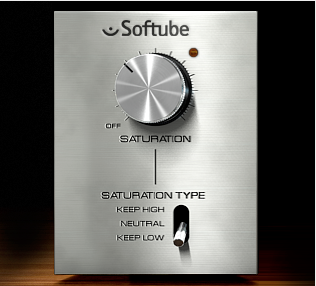 • saturation: Saturation Knob by Softube
• saturation: Saturation Knob by Softube
If you don’t have this one, stop reading this post and just go get it now: it’s free. Really good saturation. Just one knob and a control switch that affects the tone: keep low squashes the low end less, keep high preserves the high freqs more, and you have neutral, too. Call me simple, but I love simple plugins, and this does a superb job at that.
• saturation / harmonic distortion: Reviver by FieldingDSP
To this day, it seems FieldingDSP only have one plugin to offer, but it does what it promises very well: provides pleasant coloration of the signal by generating 2nd and 3rd order harmonics. Both amounts are controlled separately; I find myself pushing the 3rd order most of the time.
For the price, Reviver is a steal. Every now and then I feel like a sound isn’t cutting well enough thru the mix, and Revive often helps to bring it out. Definitely one of those 5% percent tools making a big difference in the end. Wouldn’t want to do without it anymore.
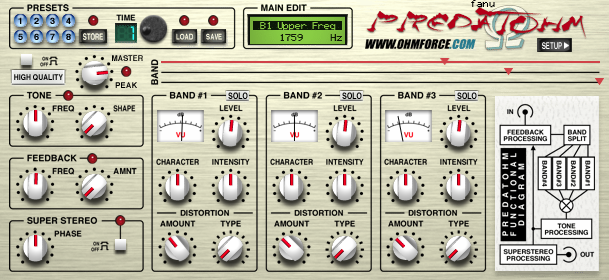 • distortion: PredatOHM by Ohm Force
• distortion: PredatOHM by Ohm Force
Probably one of my oldest plugins. Still love it! It’s ballsy and can be really phukking phukked, too! The company promises “that BIG PHAT sound”. Yup, that’s what it does.
You get to choose the type of distortion, and there’s several. You also get feedback for ultimate destruction, as well as Super Stereo, which is kind of worthless in terms of actually mono-compatible stereo widening but good old fucked stereo fun FX-wise.
PredatOHM isn’t just for phuckedness: it can actually give your breaks a nice, round, ballsy tone, and that’s what made me fall in love with it in the first place. Another no-brainer for the measly price.
 • EQ/preamp/saturation/etc: Nebula by Acustica Audio w/ MFC console by AlexB
• EQ/preamp/saturation/etc: Nebula by Acustica Audio w/ MFC console by AlexB
For the sake of brevity, I’ll skip explaining what Nebula is, but I’ll say it’s a multi-effect plugin that lets you use all sorts of programs, many of which are analog-modeled; they’re not algorithm-based programs. So, in other words, Nebula doesn’t work alone; you’ll load programs by different vendors into it.
I’ve bought some Nebula programs, and there’s plenty of freebies if you just google around, too, but I’ve found that the Modern Flagship Console by AlexB has a preset called “Air & Punch” that really does make the sound more weighty and airy. I know some things are hard to describe with words, so you’ll have to take that in need of a better description. Powerful, powerful stuff here. There’s been some cases where I’m done with a mix but miss that certain weight and clarity, and this has given me just that a few times already.
I’ve also been using Powered Bus by SignalToNoize and liked it.
Nebula works a bit differently from your regular algorithm plugin, but it’s all worth learning. Really want to get deeper with it myself.
(quick honourable mention: Saturn by Fabfilter. Only a quick mention because I only got it recently. Superdope multiband distortion with modulation options, feedback, etc…can be a great tool in fucking things up, achieving the perfect tone for your breaks, and just about everything in between…try running your reverb tail into a crazy feedbacked Saturn band, for example)
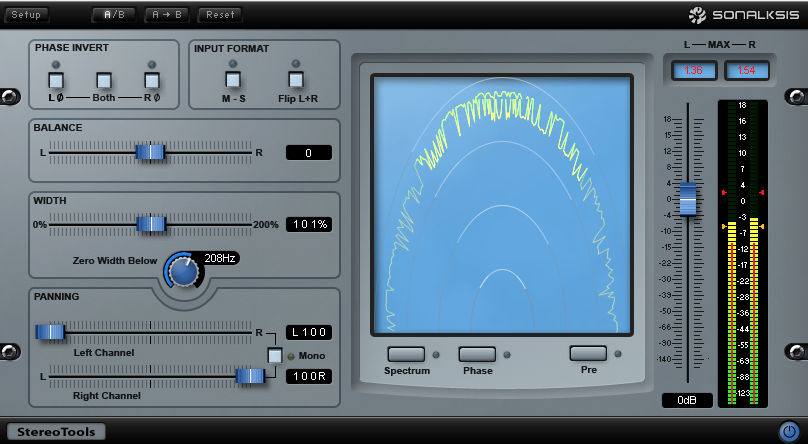 • stereo imaging tool / “bass monoizer”: StereoTools by Sonalksis
• stereo imaging tool / “bass monoizer”: StereoTools by Sonalksis
Stereo imaging/metering/manipulation tool. Mostly rock it for its zero width below function in the beginning of my mastering chain. Also handy for seeing whether your stereo is getting out of hand and adjusting stereo width. Simple, and I like how it looks.
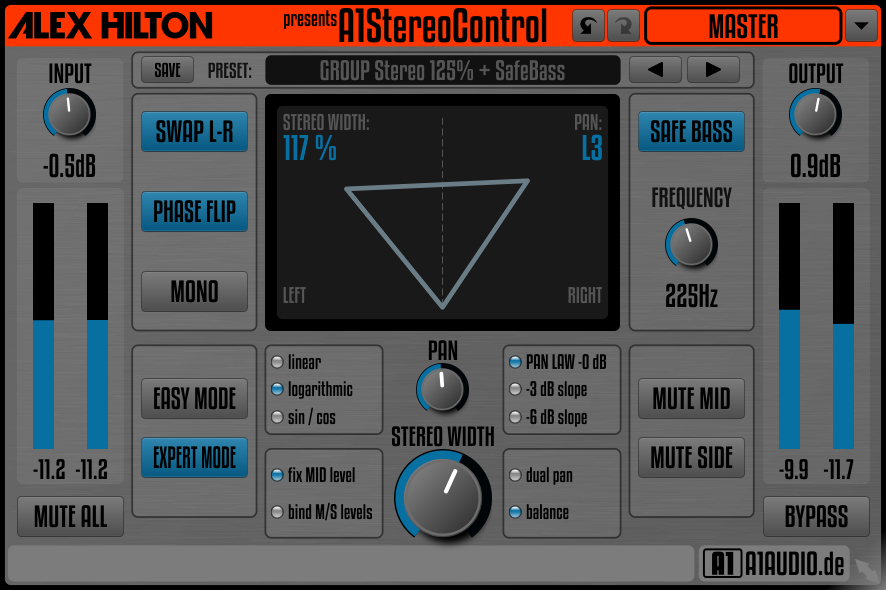 • stereo imaging tool / “bass monoizer”: A1StereoControl by Alex Hilton
• stereo imaging tool / “bass monoizer”: A1StereoControl by Alex Hilton
If I needed a free plugin to mono my bass, I’d recommend the A1StereoControl by Alex Hilton, which works really well. Has that stereo width, too for controlling/expanding width.
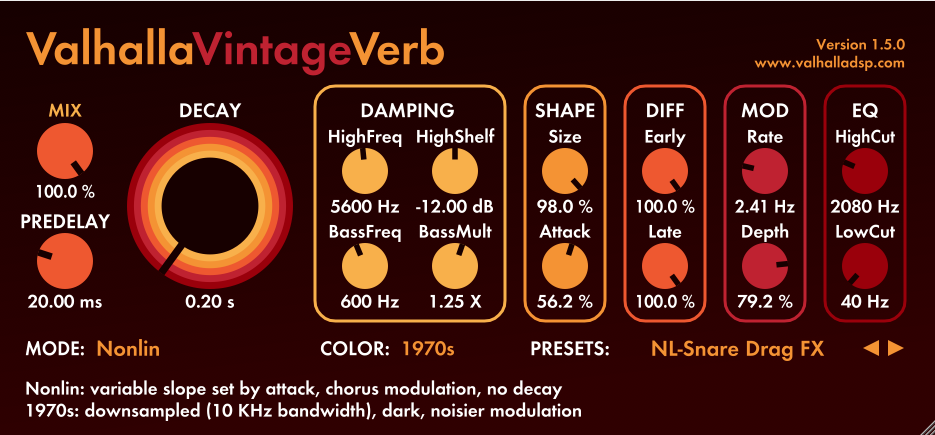 • reverb: Valhalla Vintageverb
• reverb: Valhalla Vintageverb
To be honest, I’m not one of those people who own a ton of reverbs. I’ve never compared them either. I used to use Ableton reverb for years before trying out anything else. I came across Vintageverb, as a lot of people were saying good things about it, and I fell in love immediately. It offers super lush tones (you can make it short and tight, too), and it’s the plugin in my default reverb bus in every project, so it gets a lot of use.
It offers three different modes: 1970s, 1980s, and NOW. They all have a different operating bandwidth and amount of modulation noise. I’ve found myself using the oldest mode the most. See this quick video on tweaking mod parameters on the fly…love how it sounds.
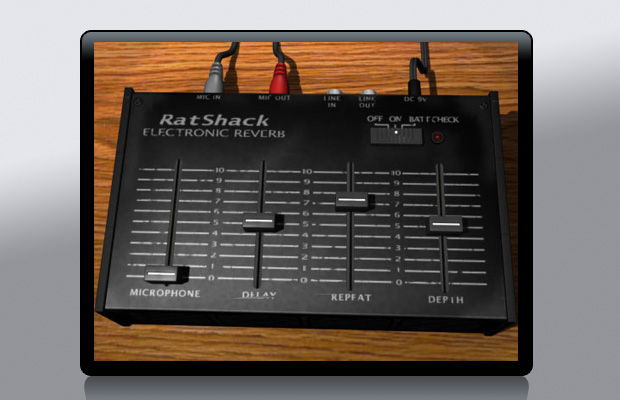 • delay: Ratshack by Audio Damage
• delay: Ratshack by Audio Damage
Honestly, everybody needs a cheap delay, right? For the lols, the company says it “features a completely re-written delay engine, which more accurately recreates the suck of the original. Never before has a vintage effect of such low quality been as painstakingly modeled as Ratshack Reverb v2.0”.
But let me tell you: in these digitally sterile times, it sounds great! It’s one of those delays you hear in dub when the sound boy quickly cranks the delay up as the snare hits, then plays around with the delay time…sounds so cheap but, ah, so badass! Love that crusty-assness. And for that price, who’s complaining?!
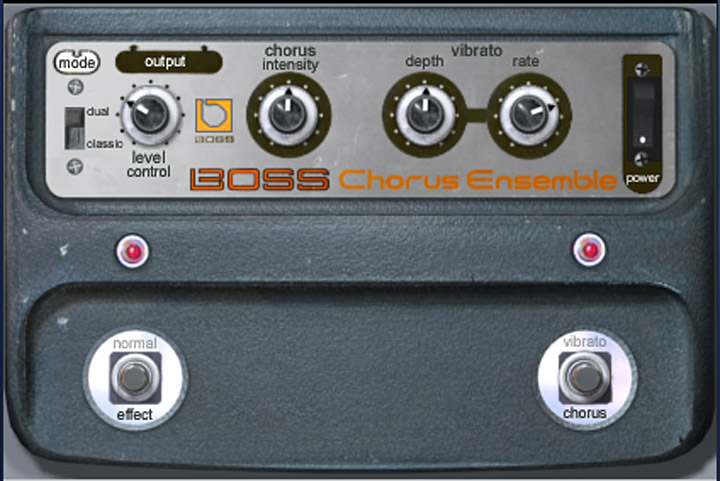 • chorus: Boss CE-1 chorus/vibrato by UAD
• chorus: Boss CE-1 chorus/vibrato by UAD
This one’s modelled after a stomp box by Boss that works as both chorus and vibrato, and I’ve only used it for the former. Definitely one of those plugins that simply works, and that’s a good sign. It’s the plugin my default reverb bus in every project. Fat. Only wish it had a HP filter, but as the original box didn’t have it either, can’t have it on this one.
 • chorus: Multiply by Acon Digital
• chorus: Multiply by Acon Digital
This one’s free, and it actually has that HP filter I’m craving for in the abovementioned Boss one. Multiply won the KVR Audio Developer contest in 2014, and that’s a sign of some greatness: you don’t win it just like that.
It actually has a knob for amount of voices ranging from 1 to 6 and stereo spread for widening them (as you may know, the function of a chorus is to make your signal sound like it was played by several players/sources). A lot of guys swear by this one today.
(honorable chorus mention: Dimension Expander by Xfer Records. A two-knob chorus thingy that’s free and sounds badass…and, uh, “expands the dimension” like a proper chorus should!)
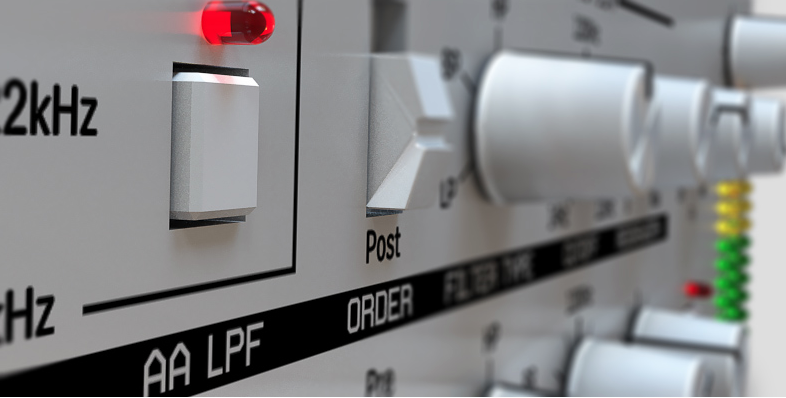 • bit crusher: Decimort by D16 Group
• bit crusher: Decimort by D16 Group
Having been a fan (and a user) of old samplers, I’ve always been a bit sceptical towards effects that say they’re recreating the coloration and “warmth” of the classic samplers or something similar or which offer presets called SP1200 like Decimort does, but at some point I got over that and accepted the fact that while they may not sound exactly like the beloved old samplers, they can sound pretty dope in their own right, and that holds true in case of Decimort, which I’ve learned to like even though I’ve never been that much of a fan of bit-crushers.
It can sound great, its presets range from subtle to radical, they’re definitely really good fun to browse, and the wet/dry control is your friend.
If you have a drumloop or just about any sample you want to make dirtier, older, or less clean, start rocking with Decimort, and I can almost guarantee you’ll get pretty close to what you were thinking of.
 • pitch shifter: Little Alterboy by Soundtoys
• pitch shifter: Little Alterboy by Soundtoys
I’ll be honest and say I’ve never been too excited about the idea of pitch-shifting plugins, and I’ve never owned one that I can remember. However, I’m always on the lookout for some interesting freebies, and I was lucky to grab this one while Soundtoys were giving it out for free, and I’m glad I gave it a test drive.
Little Alterboy is a radical tool that mangles your audio into something else by shifting it up or down using different algorithms, and it’s tweaking the parameters where the fun comes in. E.g., I recently made an eerie pad sound out of a uselessly stupid scream sample I should’ve deleted off my HD ages ago…came out great.
Ever since I’ve been using the plugin every time I want to come up with something strange I wouldn’t otherwise think of, and Little Alterboy hasn’t let me down once in that department!
(honorable pitch editor + instant harmonizer mention: Vielklang by ZPlane. Only got this recently and had a test drive with a vocal track, but the harmony that Vielklang generated was seriously impressive and I know I’ll be using it in the future. I got it with a Computer Music issue once again, so make sure you cop Vielklang for a measly price of a magazine!)
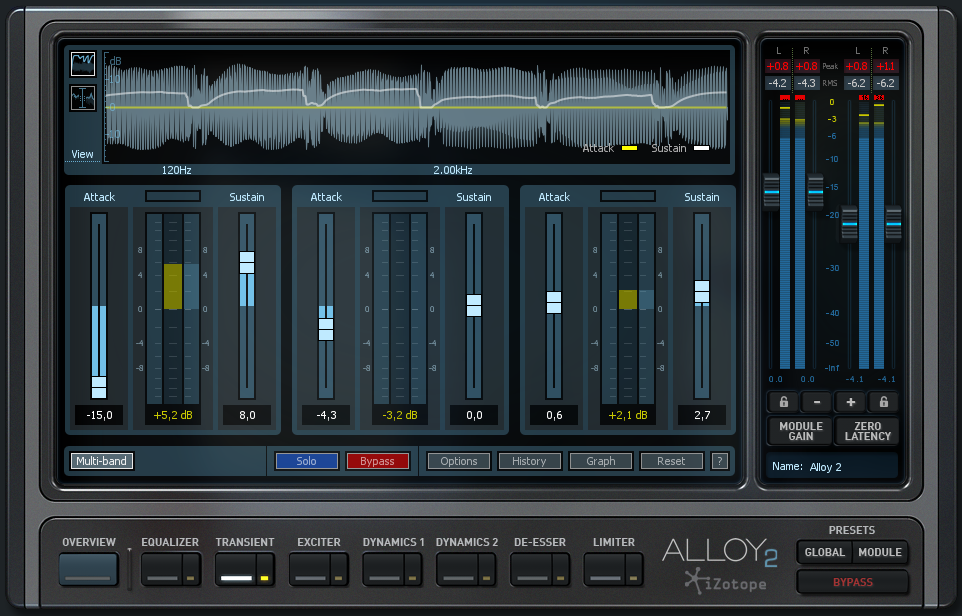 • transient tool: Alloy 2 by Izotope
• transient tool: Alloy 2 by Izotope
Alloy 2 is a channel strip, but not your traditional one: it features a whole lot of stuff. What I want to mention it for specifically is its Transient Shaper module, which lets you control the transients of your signal: make a sharp snare softer or a soft one punchier, make a kick a bit less boomy, enhance the pluck of a guitar, etc. Not only does it let you enhance or tame the snap, it also allows you to control the sustain, too, if you want to make it sound “longer” (this can be super great for some quick drum fill on/off automation, for example).
Its multiband option is great, too, as it lets you control low/mid/high frequencies separately.
Alloy is simply a godsend when it comes down to getting meticulous in getting a break to sound just right (often times you may not even realize how much it can enhance the drums until you try it).
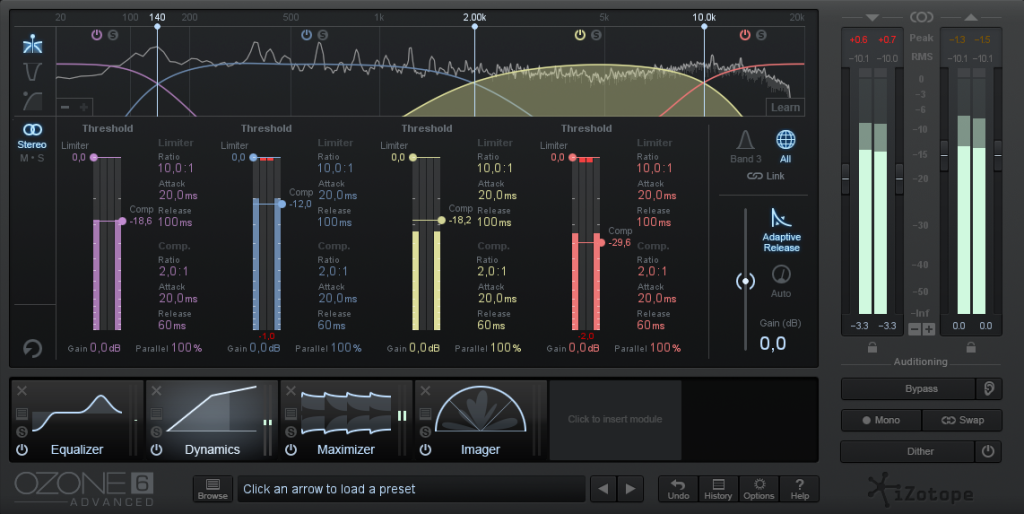 • mastering tool: Izotope Ozone
• mastering tool: Izotope Ozone
(I wrote about Ozone in detail in my mastering post, so for the sake of brevity I won’t do that again here.)
Ozone features six different modules: EQ, dynamics, dynamic EQ, exciter, imager, and maximizer (limiter). Basically, it is a mastering tool, but its advanced version allows you to use them as separate plugins, and I love that, so it’s not only mastering that I use Ozone for.
Ozone features several presets, but personally, I’ve never used one, reason being I wanted to learn how mastering (as well as Ozone) works one step at a time, but the presets might be a good starting point allowing for further tweaking – but remember that they are guesses at best because all songs are different.
It’s a shame that Izotope dropped the gate out of its dynamics module in version 6, but for that I’m still using the dynamics module of Ozone 5 when needed (e.g., for gating drums as in this quick video tip).
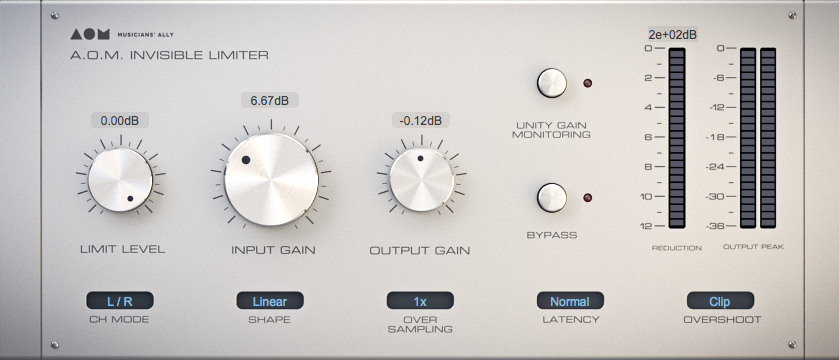 • limiter: Invisible Limiter by A.O.M.
• limiter: Invisible Limiter by A.O.M.
I’m always saying this one’s a “simple” limiter because compared to a lot of other limiters out there, it doesn’t have that many parameters you can mess with; e.g., its attack and release times are optimised, and the developer says its limiting algorithm “minimizes the difference between the original and the limited signals”.
All this works really well, I must say, and this one’s always in my mastering chain, and it’s probably the most transparent and loudest limiter I know. Sometimes I use it in conjunction with Ozone, sometimes alone (in general it’s not a bad idea to share limiting or compression between two plugins especially if you gotta go heavy on limiting; sometimes I may do half of the heavy lifting with the first one, then the rest with the second).
I also use a limiter as a tool in mixing process. I use a limiter to check the mix in such way that I push the song to a “competitive level”, i.e., to a level of my reference tracks and see how well it can take it (e.g., if I have too much bass, I can hear it distorts, so I take the bass down a bit and always try to make the mix as good as I can before entering mastering process. I want to emphasize, though, that mixing and mastering are two separate processes for me AND that I don’t recommend mixing into a limiter early in the mixing process.
A.O.M. offers the options of doing an annual payment or paying for a lifetime license in one go, which is a nice idea, IMHO.
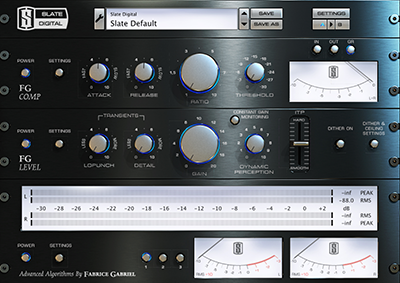 • limiter: FG-X by Slate Digital
• limiter: FG-X by Slate Digital
Whereas Invisible Limiter is simple, FG-X offers more features (including a compressor). The reason I want to mention FG-X here is that I like its transient-enhancing features; it has knobs such as lopunch and detail as well as dynamic perception. Traditional limiters don’t always offer such luxury, and especially the detail knob can be amazing in bringing out some percussive elements (bongos, hihats, stick sounds etc), and that’s what I’ve been using the FG-X the most for.
 • clipper: KCLip by Kazrog. Got this one very recently and did some quick tests with it, and was quite impressed especially in terms of pushing breaks; you can totally smash the peaks yet achieve a pleasing round tone. Mind you, this isn’t a limiter per se (technically speaking, clipper is a limiter with zero attack and release time). KClip has a “soften” knob, though, so you can introduce a softer tone.
• clipper: KCLip by Kazrog. Got this one very recently and did some quick tests with it, and was quite impressed especially in terms of pushing breaks; you can totally smash the peaks yet achieve a pleasing round tone. Mind you, this isn’t a limiter per se (technically speaking, clipper is a limiter with zero attack and release time). KClip has a “soften” knob, though, so you can introduce a softer tone.
Clippers are used to gain more headroom by squashing peaks of signals, and this does a terrific job at that, and is very inexpensive, so there’s barely a reason not to buy it if you need quality clipping action in your life.
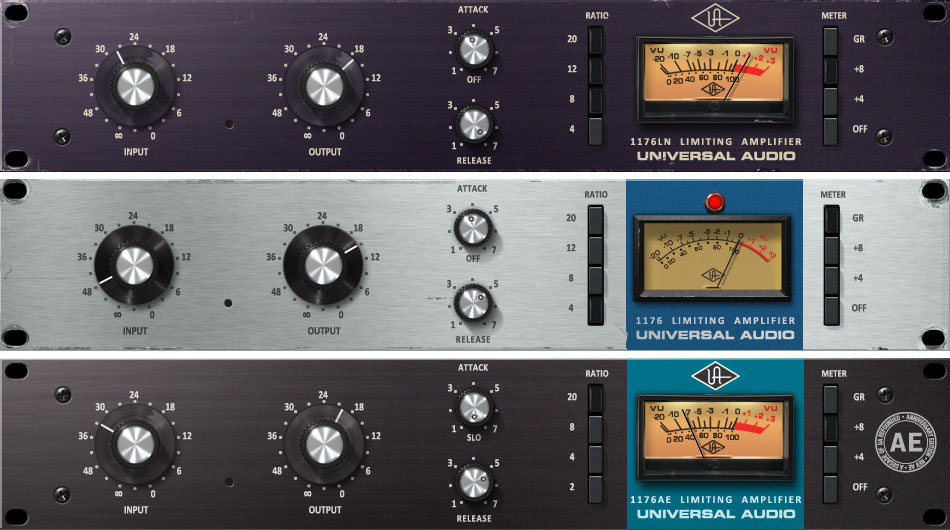 • compressor: 1176 Classic Limiter series by UAD
• compressor: 1176 Classic Limiter series by UAD
Truth be told, I’ve always used compression sparingly and only when it feels absolutely necessary. I’ve found that the 1176 series takes care of the compression duties whenever I need it. You can go light with it (as I usually do) or go crazy with the all-knobs mode that the 1176 is famous for. Also introduces some nice distortion.
The collection has three different models with different sonic qualities. If only it had a wet/dry control for that parallel comp business.
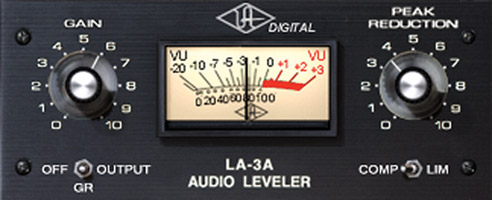 • compressor: LA3 by UAD
• compressor: LA3 by UAD
Another plugin I can’t say much about other than it works and that it has very few controls. Every time I receive a vocal track that’s too pokey and which needs to be controlled, I know this is the one I’ll run it thru and it’ll sound absolutely great.
(honorable quick compressor mention: MJUC by Klanghelm. Not many plugins have been enjoying as much hype and praise after their launch as MJUC. Got it only recently myself, and have been messing with it a lot, pushing bass etc into it and have been pleased with the results you can get by messing with the timbre and drive controls, because I like really good saturation, and MJUC does offer that. Also, once again, killer price…get it while it lasts.)
 • leveler: VUmeter by Hornet Plugins
• leveler: VUmeter by Hornet Plugins
In simple terms, this one makes sure your signal is running at safe levels. Why care about levels in digital domain? Sure, we have unlimited headroom in 32-bit floating point engines that many DAWs have and even though we can run the tracks red and it’s OK, fact is that not all plugins can handle loud input levels very well, and running signal too loud into some plugins may degrade if not destroy your signal. Some analog-modeled plugins (such as Nebula programs) will pretty literally destroy your signal unless you run it in at moderate levels.
VUmeter makes sure that won’t happen – it simply turns your signal down to a decent level and keeps it there.
Should you want more reading on the topic, see here.
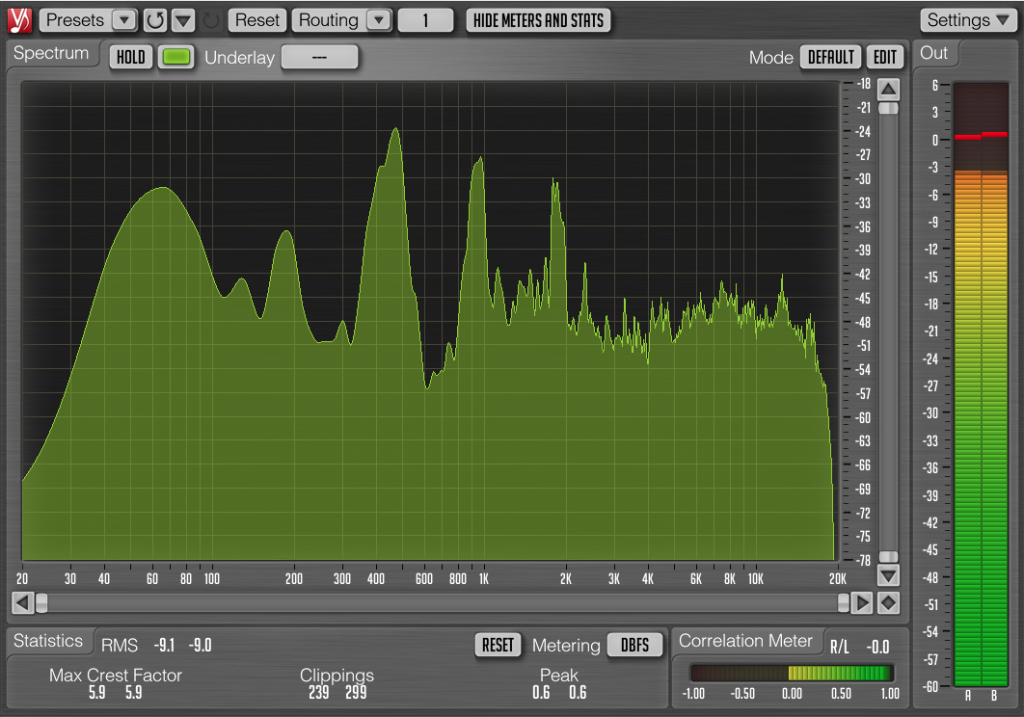 • spectrum analyzer: SPAN by Voxengo
• spectrum analyzer: SPAN by Voxengo
If not an industry standard, this is probably the one that gets used the most when it comes to taking a look at your sound. And it’s free!
I love it, and it’s the very last plugin at the end of my mastering chain. As much as I trust my hearing, I still like to see that some things are exactly right, and in mastering I do want to take a look at the sub, for example, to make sure there’s enough of it and that it’s in the right area frequency-wise.
I have written about how you can use SPAN when getting your sub bass right and high-passing your songs the right way.
In addition to the very fast default mode, I also like the average mode, which gradually slows down and reveals any possible peaks in the sound so you know where to cut a little.
If you made it this far, thank you / good job! For I barely did.
If you happened to like what you read or found something useful OR came up with some questions, feel free to comment below. Also, if you liked it enough, sharing the post would be superb, as the content of a small blog like this gets shared best on word-of-mouth basis.
You might also like my other music production related posts.
Happy music-making!

